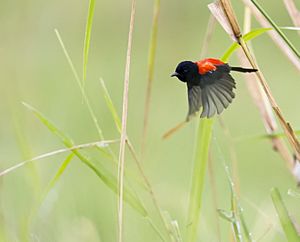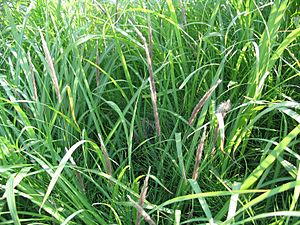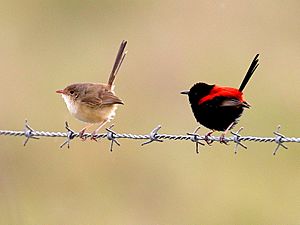Red-backed fairywren facts for kids
Quick facts for kids Red-backed fairywren |
|
|---|---|
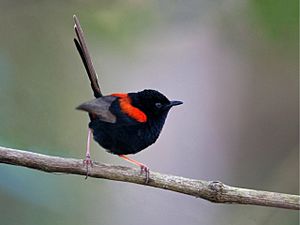 |
|
| Male | |
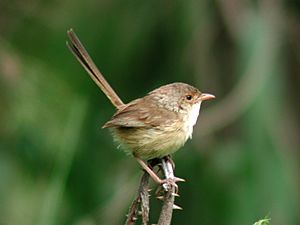 |
|
| Female at Samsonvale, SE Queensland | |
| Conservation status | |
| Scientific classification | |
| Genus: |
Malurus
|
| Species: |
melanocephalus
|
| Subspecies | |
|
|
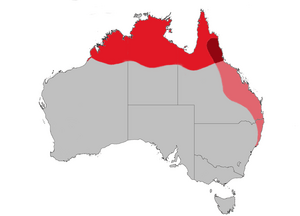 |
|
| Red-backed fairywren range
M. m. melanocephalus; M. m. cruentatus; broad hybrid zone
|
|
| Synonyms | |
|
|
The red-backed fairywren (Malurus melanocephalus) is a small, colorful bird found only in Australia. It belongs to the Australasian wren family. You can spot it near rivers and along the northern and eastern coastlines. Its range stretches from the Kimberley in Western Australia to the Hunter Region in New South Wales.
Male red-backed fairywrens are very striking during breeding season. They have a black head, back, and tail, with a bright red back and brown wings. Females are mostly brownish on top and lighter underneath. Young birds and males not in breeding colors look similar to females. Some males even breed while still in their non-breeding plumage.
This fairywren mostly eats insects. It also adds seeds and small fruits to its diet. It prefers to live in heathland and savannah areas. These places have low shrubs and tall grasses for cover. Red-backed fairywrens can move around a lot in areas with frequent bushfires. However, in other places, pairs or small groups of birds will defend their territory all year.
Groups usually include a pair and one or more "helper" birds. These helpers are young birds from previous years. They stay with the family to help raise the new chicks. Sometimes, a red-backed fairywren might mate with another bird. It may even help raise the young from those pairings. Older males with bright breeding colors are more likely to do this. As part of their courtship display, male wrens pick red flower petals. They then show these petals to females.
Contents
About the Red-backed Fairywren
The red-backed fairywren is one of eleven species in the Malurus genus. It is closely related to the white-winged fairywren in Australia. It is also related to the white-shouldered fairywren found in New Guinea. These three species are known as "bicoloured wrens." They do not have head patterns or ear tufts. Instead, they have solid black or blue bodies with contrasting shoulder or wing colors. They live in different areas across northern Australia and New Guinea.
Subspecies of Fairywrens
Scientists recognize two main types, or subspecies, of the red-backed fairywren:
- M. m. cruentatus: This subspecies is found across northern Australia. It lives from the Kimberleys to northern Queensland. It is smaller than the other subspecies. Males weigh about 7.1 grams, and females weigh about 6.6 grams. Males on Melville Island have a deeper red color on their backs.
- M. m. melanocephalus: This subspecies is found along the northern coast of New South Wales up to northern Queensland. It has an orange back and a longer tail. It has also been called the orange-backed fairywren.
There is a special area in North Queensland where these two subspecies meet. This area is called a "hybrid zone." Here, you can find birds that look like a mix of both types.
How They Evolved
Scientists believe the ancestors of these two subspecies were separated a long time ago. This happened during the last ice age, about 12,000 years ago. Dry conditions pushed the birds' preferred grasslands north. Later, when it became wetter and warmer, they spread south again. This is how the eastern and northern forms met in Queensland.
What the Red-backed Fairywren Looks Like
The red-backed fairywren is the smallest bird in its group. It measures about 11.5 centimeters (4.5 inches) long. It weighs between 5 and 10 grams (0.18 to 0.35 ounces). Its tail is about 6 centimeters (2.4 inches) long. The tail is black on breeding males and brown on females, young birds, and non-breeding males. Its beak is long, narrow, and pointed. It is shaped well for picking insects.
Male and female red-backed fairywrens look very different. This is called sexual dimorphism. Males get their full breeding colors by their fourth year. This is later than most other fairywrens. A breeding male has a black head and body with a bright red back and brown wings. At other times, it has a brown upper body and white underparts.
Females look similar to non-breeding males. They have a buff-brown body and a yellowish spot under the eye. Unlike other fairywrens, the female's tail does not have a blue tint. Young birds of both sexes look much like the females.
Sounds and Calls
The red-backed fairywren's song is used to mark its territory. It sounds like a "reel" of notes. The song starts soft and low, then becomes high and shrill. Males sing this song mostly during mating season.
When foraging, birds make a soft "ssst" sound to talk to each other. This call is hard to hear from far away. Their alarm call is a high-pitched "zit."
Where They Live and Their Home
The red-backed fairywren lives only in Australia. You can find it along rivers and coasts. Its range goes from Western Australia, through the Kimberleys and Arnhem Land, to Cape York. It also lives on nearby islands like Groote Eylandt and Melville Island. Its range extends down the east coast to the Hunter River in New South Wales.
These birds prefer wet, grassy areas in tropical or subtropical climates. They like tall grasses such as bladygrass (Imperata cylindrica), Sorghum, and Eulalia. They are not true migratory birds. However, they might move locally if the plants in their area change. They also hide in fire-resistant places during bushfires. The red-backed fairywren avoids dry areas. The white-winged fairywren lives in the drier areas to the south.
Behavior and Daily Life
Red-backed fairywrens are active during the day. They start moving at dawn and have bursts of activity throughout the day. When they are not looking for food, they often rest together. They roost close to each other in thick bushes and groom each other.
They usually move by hopping, with both feet leaving the ground at the same time. But they can run very fast when they do a "rodent-run" display. Their long tail helps them balance. It is usually held upright and is rarely still. Their short, rounded wings are good for short flights, but not for long journeys. They usually fly in wavy lines for about 20 to 30 meters (65 to 100 feet).
In some dry, tall grasslands, the plants change a lot due to fires or wet season growth. In these areas, the birds might move around more and change territories more often. In other places, like coastal areas, they keep more stable territories.
Sometimes, both male and female red-backed fairywrens use a "rodent-run" display. They do this to distract predators from their nests. The bird lowers its head, neck, and tail. It holds its wings out and fluffs its feathers. Then it runs quickly while making a continuous alarm call.
Courtship and Reproduction
During the mating season, the male's brown feathers are replaced by fiery red ones. He might puff out his red back and shoulder feathers. This makes them cover part of his wings in a "puffball-display." He will fly around and confront other males. He also picks red petals and sometimes red seeds. He then presents them to other birds. Most of the time, he gives these to a female as part of a courtship ritual. Sometimes, he gives them to another male as a sign of aggression.
More than half of the red-backed fairywrens in an area form pairs during mating season. This helps them survive when food is scarce. It is harder to keep a large group together during dry times. So, the birds try to stay in pairs or smaller groups. These groups include adult helpers who assist the parents in caring for the young.
Paternity tests show that older males with bright colors are more successful at mating. They can mate with more than one female. A male with duller colors or a younger male has less success. An unpaired male will often help a mated pair feed and care for their young. After a male pairs up, his beak darkens within three weeks. This change is faster than feather molting.
The mating season runs from August to February. This time matches the rainy season in northern Australia. The female does most of the nest building, but the male helps. This is not common for other birds in the Malurus group. The nest is round and hidden in grass or low shrubs. It is made of dried grasses and lined with finer grasses and hair. Nests in southeast Queensland are usually larger and messier than those in northern Australia.
Building the nest takes about one week. Eggs are laid up to seven days later. The female lays three to four white eggs with reddish-brown spots. The eggs are incubated by the female alone for two weeks. The young birds stay hidden in the nest for one week after hatching. They depend on their parents and helpers for about one month. They learn to fly between 11 and 12 days after hatching. Young birds hatched earlier in the season will help raise later broods. They stay with their family group for the season after they hatch.
What They Eat
Like other fairywrens, the red-backed fairywren mainly eats insects. They eat many different kinds of insects. These include beetles, bugs, grasshoppers, moths, wasps, and cicadas. They also eat insect larvae, eggs, and spiders. Seeds and other plant material make up only a tiny part of their diet. They hunt for insects in leaf litter, bushes, and near water. They mostly forage in the morning and late afternoon. Both adult males and females, as well as helper birds, feed the young.
Predators and Dangers
Adult red-backed fairywrens and their young can be hunted by many animals. These include mammals like feral cats and red foxes. Reptiles like goannas and rodents also prey on them. Native predatory birds like the Australian magpie, butcherbirds, blue-winged kookaburra, crows, ravens, and shrike-thrushes are also a threat.
Images for kids
See also
 In Spanish: Ratona australiana de lomo rojo para niños
In Spanish: Ratona australiana de lomo rojo para niños



